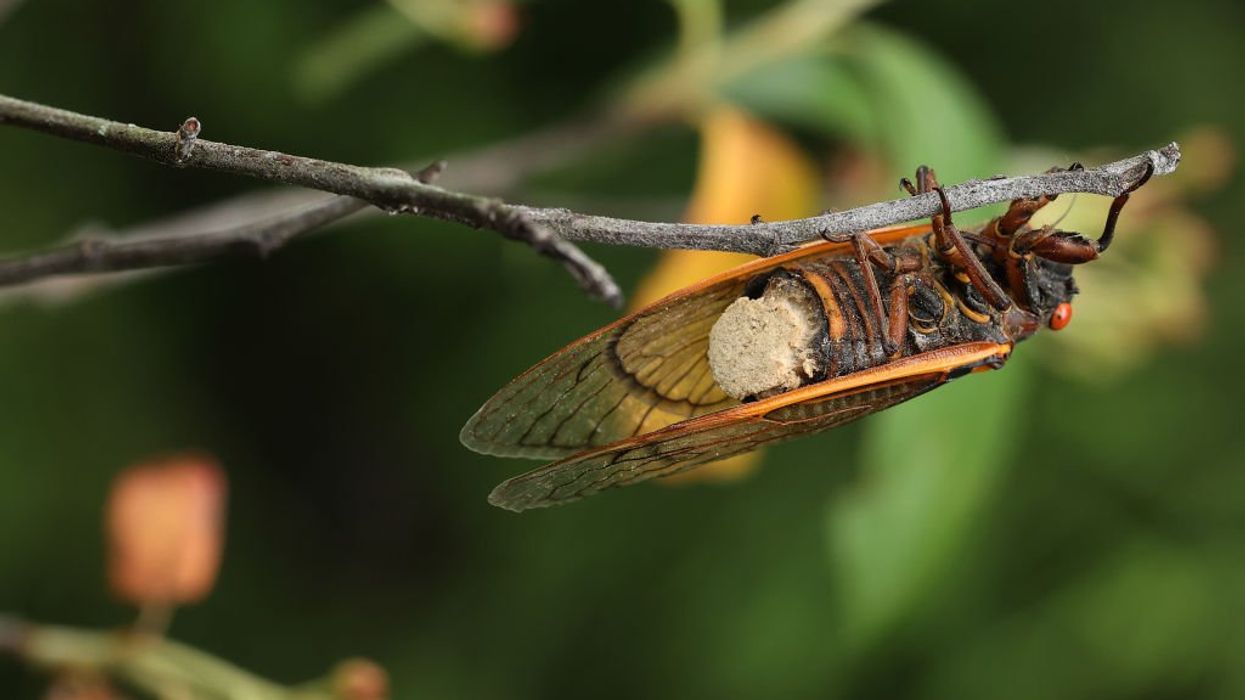
An infected cicada. (Photo by Chip Somodevilla/Getty Images)

One scientist said that once taken over by the fungal parasite Massospora cicadina, the bugs become 'saltshakers of death.'
The fungal parasite Massospora cicadina not only cohabits and transmogrifies the bodies of its hosts, but bends their will to its purposes, spreading death, destruction, and spores along the way.
While this might sound like some sort of a demonic possession, scientists have characterized the process by which such Entomophthoralean fungi — an order of fungi that takes its name from the ancient Greek words for "insect" and "destruction" — subvert host structures and behaviors for their own aims as the modification of host phenotypes.
Whereas Entomophthoralean fungi largely kill their hosts in order to disseminate its spores, Massospora cicadina keeps its host alive.
There are two types of Massospora cicadina infections. Cicadas with stage one infections produce spores capable of infecting other adult cicadas. Cicadas with stage two infections lay fungal traps for the next generation of cicadas that will emerge from the soil some 13 or 17 years later.
Up to 10% of both a 13-year brood and a 17-year brood will face the possibility of becoming "zombie insects" this year. The University of Connecticut's Biodiversity Research Collections Periodical Cicada Information website indicated that for the first time since 2015, a 13-year brood will emerge in the same year as a 17-year brood.
A study published in the peer-reviewed Nature journal Scientific Reports noted that infections cause "distention and loss of the terminal abdominal segments, genitalia included, in both sexes; the breached abdomen exposes infective spores and allows their dispersal."
One of the study's authors, Dr. John Cooley, an associate professor of ecology and evolutionary biology at the University of Connecticut, Hartford, recently told CNN that when it comes to this fungal parasite, "the truth is actually much stranger than science fiction."
After an infected cicada's genitals and rear fall off, a white fungal plug bulges out in their place.
Matt Kasson, an associate professor of mycology and forest pathology at West Virginia University, told CNN, "It looks like there's a gumdrop that's been dropped in chalk dust, glued to the backside of these cicadas."
Some scientists have observed cicadas with stage one infections flying less often and opting instead to drag around their spore-laden abdomens, spreading spores and looking for potential victims. Cicadas with stage two infections apparently spend more time flying around, bombing spores from their corrupted abdomens.
Both sexes with stage one infections apparently become hypersexual in an effort to serve the parasite's purposes.
'So when they pull apart, guess what happens? Rip.'
Infected males try to maximize the victim coverage, exhibiting the wing-flick signaling-behavior "normally seen only in sexually receptive female cicadas" in an effort to trick other males into thinking they are females keen on copulating. By the time male victims realize their mate is not as advertised, it's often too late as the spores spread easily in close proximity.
Female cicadas are apparently incapable of identifying and avoiding infected males, so they too are at risk.
Cooley's study noted that "Massospora functions at least partly as a sexually transmitted disease and the novel behaviors of infected males are complex manipulations instigated by the fungus for its own benefit."
Deception is not the only way the infection is spread.
"Periodical cicadas have interlocking genitalia. So when they pull apart, guess what happens? Rip. And then there's a cicada walking around with someone else's genitals stuck to them," said Cooley. "And now the cicada that's infected is busted open."
Once "busted open," infected cicadas become what Kasson and others refer to as "saltshakers of death."
They fly around, flaking brown spores that threaten to infect the next brood.
Kasson and other scientists determined that infected cicadas are likely able to keep moving and mating despite their injuries because the fungus produces psychoactive compounds during infection. The first is a type of amphetamine, cathinone. The second is psilocybin, the psychedelic compound in magic mushrooms, in infected cicadas.
Cooley has, however, expressed uncertainty whether such drugs would affect the bugs in a similar manner as they do vertebrates.
Like Blaze News? Bypass the censors, sign up for our newsletters, and get stories like this direct to your inbox. Sign up here!